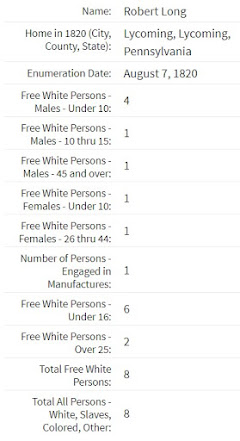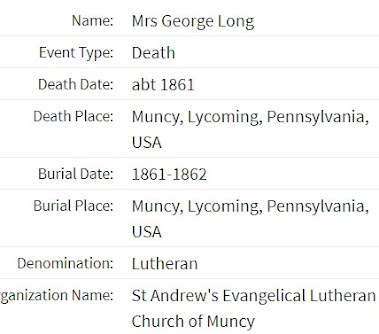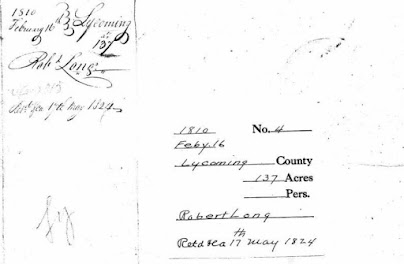(Scroll down for the english version)
Mon hypothèse concernant la famille de John R. Long
Sybilla Long-Hughes
I was born on Feb 16 1850 in Erie Co Pennsylvania.
Father's name was John R. Long, born in Germany.
Mother's name was Sarah Piper born in England.
(Traduction)
Sybilla Long-Hugues
Je suis née le 16 février 1850 dans le comté d'Erie PA.
Mon père était John R. Long né en Allemagne.
Ma mère était Sarah Piper née en Angleterre.
Il y a plusieurs années, nous avons appris que l'ancêtre de Darl Long de la PA, John R. Long, était d'origine allemande et que nous avons un lien de parenté avec Darl. Cette information nous provient de la fille de John R., Sybilla Belle Long. Un lien de parenté tel que précisé par un test Y-ADN comporte divers degrés. Le résultat de ce test ne signifie pas que mon ancêtre Philip Long est né en Allemagne. Mais, il est évident que certains de mes ancêtres ont déjà vécu en Allemagne.
D'après des recensements, nous savons de John R. qu'il est né en PA et son père aussi. Rien à y faire, nous n'avons pas trouvé de dossiers pertinents concernant ses parents. En fait, j'en ai trouvés que j'ai laissés sur le réchaud et que j'ai décidé de revisiter. Je publie le résultat sous le format d'hypothèse, ne pouvant faire mieux après tout ce temps.
La note que je vous ai présentée est celle écrite par Sybilla (Belle) Long-Hugues. Elle a dit que sa mère est née en Angleterre: c'est un fait. Je vous ai déjà fait part de la documentation à ce sujet dans une publication antérieure. Je crois donc qu'elle dit vrai en parlant des origines de son père John R. Il y avait des Long en Allemagne à cette époque. Sybilla a écrit que son père était né en Allemagne. Par contre, John R. a plutôt indiqué que lui et son père sont nés en PA.
Dans les dossiers relatifs à John R., sa date de naissance varie de 1814 à 1817. Lors d'un recensement, John R. n'était peut-être pas présent et une autre personne au foyer a indiqué son âge approximatif.
Dans le recensement de 1850 qui suit à Gaines, Orleans, New York, il serait né aux environs de 1814.
Par ailleurs, dans le recensement de 1860, on indique qu'il est né en 1815.
Lors de son décès en 1864, on a indiqué qu'il est né en 1817. Pour la variété, on ne peut guère trouver mieux. Cependant, ce n'est pas inhabituel dans ces documents à cette époque.
Des résidents de la PA qui ont des origines allemandes, il y en a partout. De nos jours, le pourcentage de résidents de souche allemande dans cet État atteint 35%. Il y a certaines localités où les descendants allemands représentaient une forte proportion. Et, quand aux individus nommés John Long au début du 19e siècle, on en compte 13 à la douzaine. Il faut prendre son mal en patience devant un tel défi et appliquer diverses stratégies de recherche plutôt que de baisser les bras.
D'abord, je sais qu'au baptême on emprunte souvent le nom des grands-parents ou des témoins. J'ai déjà décrit la méthode utilisée par les Allemands pour mieux identifier les ancêtres dans une famille à partir du nom des enfants. Je me suis donc intéressé surtout à George Jackson Long, premier enfant de John R. & Sarah Piper. Comment des descendants d'Allemands peuvent-ils emprunter des noms britanniques? C'est sûrement pour mieux se fondre dans le paysage des É-U.
Ensuite, j'ai répertorié les endroits où le nom de George Long figurait dans les documents pour les années allant de 1775 à 1850, en supposant que le grand-père de George Jackson portait le nom de George. Je me suis retrouvé dans le comté de Lycoming où on retrouvait une forte présence allemande. Il y avait là aussi une localité du nom de Jackson. Même qu'un George Long a été enterré là en 1851 et son épouse Catherine en 1850. Et dans ce comté, j'ai trouvé un grand nombre de Long établis dans diverses localités. Vous imaginez bien que Robert Long m'a captivé et voici pourquoi. Il s'agit du recensement de sa famille à Lycoming, comté de Lycoming, PA en 1810.
On indique qu'il y a quatre garçons âgés de 10 ans ou moins. J'ai donc prélevé le recensement de 1820 avec le résultat suivant. Il y a toujours quatre garçons de moins de 10 ans, donc nés entre 1811 et 1819.
Le recensement de 1830 est le suivant. Il y a un adolescent né entre 1816 et 1820. Il pourrait bien être John R., fils de Robert. Il est possible aussi que John R. ait quitté la maison à cette date, s'il s'agit bien sûr de sa famille.
J'ai accumulé plusieurs dossiers Long dans ce comté et j'ai scruté plusieurs arbres de famille. Nul doute qu'un grand nombre d'entre eux avaient des ancêtres allemands. Par contre, je n'ai pas trouvé de documents qui me permettent de savoir qui étaient les parents de Robert. Je crois que Robert avait un lien de parenté avec George qui demeurait non loin à Jackson, Lycoming PA.
Par hasard, j'ai aussi trouvé un certificat de mariage entre Jacob Long & Ann Eliza Piper. Je n'ai pas pu suivre à la trace ce couple. Mais, il y avait plus d'un Jacob Long dans le comté de Lycoming à cette époque. Je répète que John R était marié à Sarah Ann Piper (née au Delaware) et que leur premier enfant, George Jackson Long, est né vers 1842. Il y avait des familles Piper dans le comté de Lycoming à cette époque et par après.
J'ai aussi des documents qui montrent que Robert a acquis des terrains à Lycoming.
La plupart des Longs de ce comté appartenaient à l'Église luthérienne comme le montre la capture d'écran suivante:
Il ne faut pas croire que ma documentation démontre hors de tout doute que Robert Long de Lycoming PA est le père de John R. Long connu comme l'ancêtre de Darl Long qui a vécu en PA jusqu'à tout récemment. Darl fait partie de notre groupehaplo. Selon nos résultats à un test Y-ADN exécuté par Ancestry, il montre une différence à deux marqueurs sur le test de 37 marqueurs entre moi (de même que Gilles Long, l'initiateur de ce groupehaplo).
Une table de probabilités indique que notre ancêtre commun le plus récent (ACPR) serait né il y a environ 17 générations passées, soit plus de quatre (4) siècles. Cet ACPR aurait donc vécu entre 1600 et 1700, sinon auparavant. Nous savons que Philip Long est né aux environs de la mitan du 18e siècle, sans plus de précision.
Il est évident que certains des ancêtres de Philip Long ont déjà vécu en Allemagne, sans savoir à quelle époque. Philip a pu naître en Allemagne comme ailleurs, au Royaume-Uni et aux États-Unis par exemple. D'ailleurs, lors de sa rencontre avec John Mann à Lac Témiscouata en 1822, un journaliste Écossais, il a affirmé qu'il était un Américain. On ne sait pas s'il a voulu indiquer qu'il était né aux États-Unis où qu'il avait simplement vécu une bonne partie de sa vie aux États-Unis. Peut-être ne le saurons-nous jamais.
Mais, la patience donne parfois des résultats surprenants. Vous savez déjà que nos espoirs se fondent sur d'autres individus qui pourraient passer un test Y-ADN éventuellement et se retrouver dans notre groupehaplo.
My hypothesis concerning the family of John R. Long
(Description)
Sybilla Long-Hughes
I was born on Feb 16 1850 in Erie Co Pennsylvania.
Father's name was John R. Long, born in Germany.
Mother's name was Sarah Piper born in England.
Several years ago, we learned that Darl Long's ancestor from PA, John R. Long, was of German origin and that we are related to Darl through a Y-DNA test. This information comes to us from John R.'s daughter, Sybilla Belle Long-Hughes.
A relationship as determined by a Y-DNA test has varying degrees of relationship. The result of this test does not prove that my ancestor Philip Long was born in Germany, but rather that some of my ancestors have lived in Germany at one time.
From another source, we know from John R. that he was born in Pennsylvania (PA) and so was his father. Nothing we can do about it, we have not found any relevant records concerning John R.'s parents. In fact, I found some that I left on the stove years ago and decided to revisit. I am publishing the result in hypothesis format, which is the best I can do after all this time.
In John R.'s records, his date of birth ranges from 1814 to 1817. During a census, John R. may not have been present, and another person in the household indicated his approximate age.
In the following 1850 census in Gaines, Orleans, New York, he would have been born around 1814.
On the other hand, in the 1860 census, he is reported to have been born in 1815.
On the other hand, in the 1860 census, he is reported to have been born in 1815.
When he died in 1864, it was reported that he was born in 1817. For variety, one can hardly find better. However, this is not unusual in these documents at that time.
Residents of PA who have German origins are everywhere. Nowadays, the percentage of ethnic German residents in that State reach 35%. There are some localities where German descendants make up a high proportion. And as for individuals names John Long in the early 19th century, there are 13 to a dozen. One must be patient in the face of such a challenge. Quiting is not an option. Here is one strategy that I used to try to find John R.'s parents.
First of all, I know that at baptism we often take the names of grandparents or witnesses. I have already described the method used by the Germans to better identify the ancestors in a family based on the names of the children. I have therefore focused on George Jackson Long, the first child of John R. & Sarah, assuming that his paternal grandfather was George. How can descendants of Germans borrow British names? It is surely to blend in better with the U.S. landscape.
Next, I listed the places where George Long's name appeared in the documents for the years 1775 to 1850. I found myself in Lycoming County where there was a strong German presence. There was also a place called Jackson. Even a George Long was buried there in 1851 and also his wife Catherine in 1850. And in that county, I found a large number of Long's settled in various communities. You can imagine that Robert Long captivated me and here's why. The following screenshot is a census of his family in Lycoming, Lycoming County, PA in 1810.
It indicates that there are four boys aged 10 years or younger. So I took the 1820 census with the following result. There are still four boys under 10 years of age, so they were born between 1811 and 1819.
The 1830 census is as follows. There is one teenager born between 1816 and 1820. He may well be John R., son of Robert. It is also possible that John R. left home on that date, if it is his family.
I have accumulated several Long files in this county and have looked at several family trees. No doubt many of them had German ancestors. However, I have not found any documents that would allow me to know who Robert's parents were. I believe Robert was related to George who lived nearby in Jackson, Lycoming PA.
By chance, I also found a marriage certificate between Jacob Long & Ann Eliza Piper. I was not able to track this couple after their marriage. But, there was more than one Jacob Long in Lycoming County at that time. I repeat that John R. was married to Sarah Ann Piper (born in Delaware) and that their first child, George Jackson Long, was born around 1842. There were Piper families in Lycoming County at that time and after.
I also have documents that show that Robert acquired land in Lycoming.
Most of the Longs in that county belonged to the Lutheran Church as shown in the following screenshot:
My documentation does not show beyond any doubt that Robert Long of Lycoming PA is the father of John R. Long known as the ancestor of Darl Long who lived in PA until recently. Darl is a member of our haplogroup. According to our results on a Y-DNA test performed by Ancestry, he shows a two-marker difference on the 37-marker test between me (as does Gilles Long, the initiator of this haplo group).
A probability table indicates that our most recent common ancestor (MRCA) would have been born about 17 generations ago, more than four (4) centuries ago. This MRCA would have lived between 1600 and 1700, if not earlier. We know that Philip Long was born around the middle of the 18th century, without further precision.
It is obvious that some of Philip Long's ancestors have lived in Germany, without knowing when. Philip may have been born in Germany as well as elsewhere, in the United Kingdom and the United States for example. In fact, during his meeting with John Mann in Lac Témiscouata in 1822, a Scottish journalist, he said that he was an American. We do not know if he wanted to indicate that he was born in the United States or that he had simply lived a good period of his life in the United States. Perhaps we will never know.
But patience sometimes gives surprising results. You already know that our hopes are pinned on other individuals who may eventually take a Y-DNA test and end up in our haplogroup.

























Aucun commentaire:
Enregistrer un commentaire